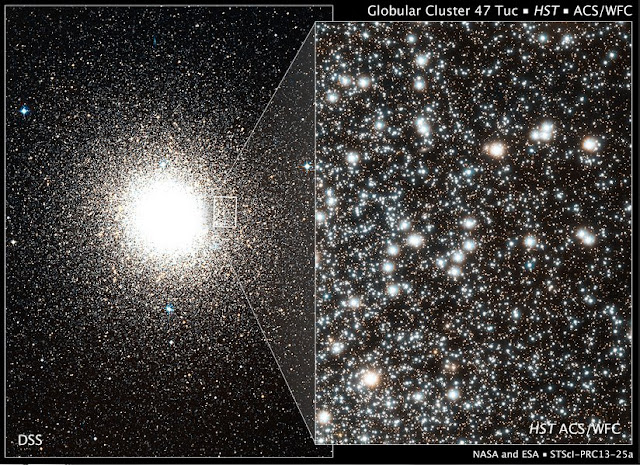NASA - Hubble Space Telescope patch.
July 18, 2013
Globular Cluster 47 Tucanae
Astronomers using NASA's Hubble Space Telescope have for the first time linked two distinct populations of stars in an ancient globular star cluster to their unique orbital dynamics, offering proof that the stars do not share the same birth date.
The analysis of the globular cluster 47 Tucanae shows that the two populations differ in age by less than 100 million years. The cluster resides roughly 16,700 light-years away in the southern constellation Tucana.
47 Tucanae — Hubble
Researchers, led by Harvey Richer of the University of British Columbia in Vancouver, combined recent Hubble observations with eight years' worth of data from the telescope's archive to determine the motions of the stars in this cluster.
Previous spectroscopic studies revealed that many globular clusters contain stars of varying chemical compositions, suggesting multiple episodes of star birth. This Hubble analysis, however, goes a step further, adding the stars' orbital motion to the analysis.
"When analyzing the motions of stars, the longer the time baseline for observations, the more accurately we can measure their motion," Richer explained. "These data are so good, we can actually see for the first time the individual motions of the stars in the cluster. The data offer detailed evidence to help us understand how various stellar populations formed in such clusters."
47 Tucanae — Digitized Sky Survey (DSS)
The Milky Way's globular clusters are the surviving relics from our galaxy's formation. They offer insights into the early history of our galaxy. 47 Tucanae is 10.5 billion years old and one of the brightest of our galaxy's more than 150 globular clusters. The cluster measures about 120 light-years wide.
Richer and his team used Hubble's Advanced Camera for Surveys in 2010 to observe the cluster. They combined those observations with 754 archival images to accurately measure the changes in positions of more than 30,000 stars. Using these data, they could discern how fast the stars are moving. The team also measured the stellar luminosities as well as temperatures.
This stellar archaeology identified the two distinct populations of stars. The first consists of redder stars, which are older, less chemically enriched, and in random, circularized orbits. The second population comprises bluer stars, which are younger, more chemically enhanced, and in more elliptical orbits.
Compass and Scale Image for 47 Tucanae
"The redder generation, which is deficient in heavier elements, reflects the initial motion of the gas that formed the cluster," Richer said. "These stars have retained a memory of their original motion."
After the most massive of these stars completed their stellar evolution, they expelled gas enriched with heavier elements back into the cluster. This gas collided with other gas and formed a second, more chemically enriched generation of stars that was concentrated towards the cluster center. Slowly over time these stars have been moving outwards, putting them on more radial orbits.
Evolution of 47 Tuc Stellar Populations
This discovery is not the first for Hubble in revealing multiple generations of stars in globular clusters. In 2007 Hubble researchers found three generations of stars in the massive globular cluster NGC 2808. Richer's team, however, linked stellar dynamics to separate populations for the first time. Finding multiple stellar populations in globular clusters has deep cosmological implications. Astronomers need to solve future enigmas of these multiple generations to better understand how stars formed in distant galaxies in the early universe.
The team's results are published in the July 1 issue of The Astrophysical Journal Letters.
The Hubble Space Telescope is a cooperative project between NASA and the European Space Agency. NASA's Goddard Space Flight Center in Greenbelt, Md., manages the telescope. The Space Telescope Science Institute (STScI) in Baltimore, Md., conducts Hubble science operations. STScI is operated by the Association of Universities for Research in Astronomy Inc., in Washington.
For more information about NASA / ESA Hubble Space Telescope: http://www.nasa.gov/hubble and http://www.spacetelescope.org/
Images, Text, Credits: NASA, ESA, Digitized Sky Survey (DSS; STScI/AURA/UKSTU/AAO), H. Richer and J. Heyl (University of British Columbia), and J. Anderson and J. Kalirai (STScI).
Best regards, Orbiter.ch






